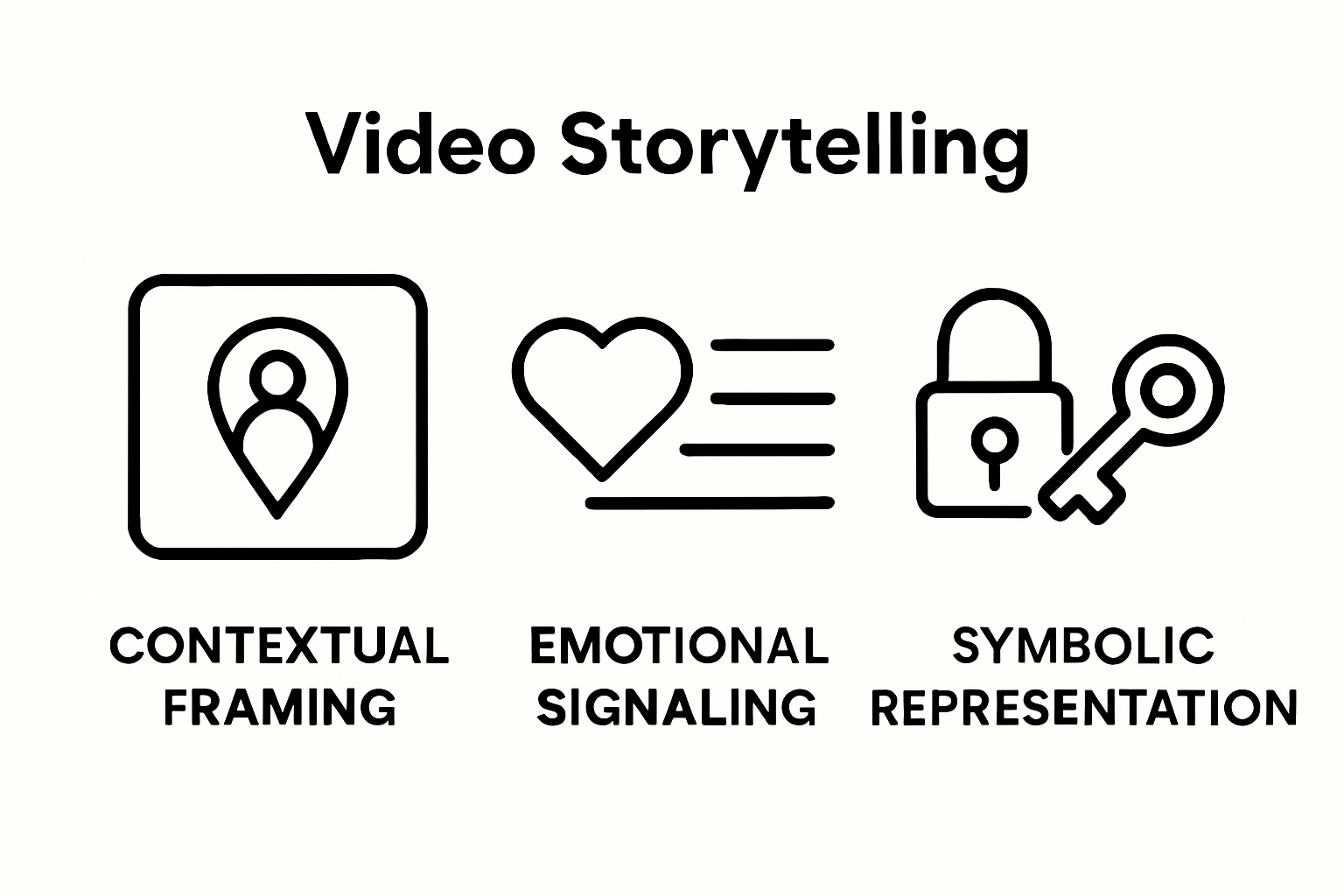Understanding the Role of Storytelling in Videos
- Pieter Nijssen
- Sep 21
- 8 min read

Storytelling in videos is everywhere now and it shapes the way we learn, feel, and remember what we watch. You might think videos already speak for themselves, but research shows compelling video narratives activate multiple regions of the brain, making the experience feel almost as real as actual life events. It turns out the secret sauce is not the visuals alone but how stories trigger a genuine emotional response that turns viewers into active participants.
Table of Contents
Quick Summary
Takeaway | Explanation |
Video storytelling engages audiences emotionally. | It transforms passive viewing into active participation by creating personal connections with the narrative. |
Effective narratives follow a structured arc. | They typically include an introduction, conflict, and resolution that guide viewer engagement and understanding. |
Engagement is driven by emotional mirroring. | Viewers reflect the emotions of characters, making the narrative more relatable and impactful. |
Clear character development enhances storytelling. | Creating relatable subjects allows audiences to connect with the narrative on a deeper level. |
Harmonizing technical and emotional elements is crucial. | Successful video storytelling integrates technical aspects with emotional insights to create immersive experiences. |
What is Storytelling in Videos?
Storytelling in videos transforms raw visual content into compelling narratives that engage, inform, and emotionally connect with audiences. Unlike traditional documentation, video storytelling weaves together visual sequences, audio elements, and narrative structures to create immersive experiences that communicate complex ideas through powerful visual communication.
The Core Elements of Video Storytelling
At its essence, video storytelling combines several critical components to create meaningful content. Learn more about audiovisual storytelling techniques that help transform simple recordings into rich narrative experiences. The fundamental elements include:
Visual Sequence: The structured arrangement of scenes that progressively reveal plot or message
Emotional Arc: The emotional journey viewers experience through the video
Character or Subject Development: Presenting subjects with depth and context
According to research exploring multimodal story understanding, effective video storytelling captures nuanced narrative events that go beyond mere visual representation. This means creating content that not only shows what happens but also communicates why it matters.
Narrative Structure in Video Storytelling
A compelling video story follows a structured approach similar to traditional storytelling formats. This typically includes:
Introduction: Setting the context and introducing key elements
Conflict or Challenge: Presenting the central problem or tension
Resolution: Demonstrating how the challenge is addressed or transformed
Video storytelling transcends simple information delivery by creating an immersive experience that resonates with viewers on cognitive and emotional levels. By strategically combining visual, auditory, and narrative techniques, videographers can craft stories that are not just watched but genuinely experienced and remembered.
To clarify the core components discussed in video storytelling, the following table defines each key element and summarizes its function in creating impactful narratives.
Element | Definition |
Visual Sequence | The structured arrangement of scenes that progressively reveal the plot or convey the video message. |
Emotional Arc | The emotional journey experienced by viewers throughout the video narrative. |
Character or Subject Development | Presenting subjects or characters with depth and context to foster audience connection. |
Clear Narrative Arc | A logical progression from introduction to resolution, guiding the story from start to finish. |
Tension and Release | Strategic pacing used to build emotional momentum and then resolve it, maintaining viewer engagement. |
The Importance of Storytelling for Engagement
Storytelling in videos goes far beyond mere information transmission. It represents a powerful psychological mechanism that transforms passive viewing into active emotional engagement, creating deep connections between content and audience. Engagement emerges when viewers feel personally invested in the narrative, moving beyond simple observation to genuine emotional participation.
Psychological Impact of Narrative Connection
Explore our advanced video storytelling techniques to understand how narratives trigger profound psychological responses. Human brains are neurologically wired to process information through stories.
Neurological research demonstrates that compelling narratives activate multiple brain regions simultaneously, releasing neurotransmitters like oxytocin that enhance emotional resonance and memory retention.
Key psychological engagement triggers include:
Emotional Mirroring: Viewers unconsciously synchronize their emotional states with narrative characters
Cognitive Investment: Stories create anticipation and curiosity, compelling viewers to remain attentive
Personal Relevance: Narratives that reflect viewers’ experiences feel more meaningful
According to cognitive neuroscience research on narrative processing, stories activate similar neural networks as direct personal experiences, making video narratives extraordinarily powerful communication tools.
Bridging Information and Emotion
Effective video storytelling bridges rational information delivery with emotional engagement. By crafting narratives that balance intellectual content with emotional depth, videographers can create memorable experiences that transcend traditional communication methods. This approach transforms viewers from passive recipients into active participants, ensuring that messages are not just understood but genuinely experienced and remembered.
How Storytelling Works to Convey Messages
Storytelling in videos operates as a sophisticated communication strategy that transcends traditional information delivery. It strategically leverages psychological and cognitive mechanisms to transform complex messages into digestible, memorable narratives that resonate deeply with audiences. The core principle is translating abstract concepts into relatable human experiences.
Narrative Architecture and Message Encoding
Explore wedding video storytelling approaches to understand how narrative structures can powerfully communicate nuanced messages. Messages in video storytelling are not simply stated but strategically embedded through carefully constructed visual and emotional layers. This encoding process involves multiple communication channels working simultaneously.
Key message transmission strategies include:

Contextual Framing: Placing information within a meaningful personal or social context
Emotional Signaling: Using visual and audio cues to guide viewer emotional interpretation
Symbolic Representation: Employing metaphors and visual symbolism to communicate complex ideas
According to research on text-to-video generation techniques, effective storytelling requires sophisticated narrative coherence that goes beyond individual scene representation. This means crafting a holistic narrative arc that guides viewers through a structured emotional and informational journey.
Cognitive Processing of Narrative Messages
Video storytelling works by aligning with human cognitive processing patterns. When viewers engage with a narrative, their brains actively reconstruct and interpret the story, creating personal meaning beyond the literal content. This active interpretation transforms passive viewing into an immersive experience where messages are internalized rather than simply observed. By presenting information through a narrative framework, videographers can communicate complex ideas more effectively, bypassing traditional cognitive barriers and creating direct emotional connections.
Key Elements of Effective Video Storytelling
Effective video storytelling transcends technical execution, requiring a nuanced approach that harmonizes visual, emotional, and narrative components. Successful storytelling creates a seamless experience that captures audience attention and communicates messages with profound impact. The art of video storytelling demands strategic integration of multiple creative and technical elements.
Structural Components of Compelling Narratives
Explore advanced video storytelling workflow strategies to understand the intricate balance of narrative construction. A robust video story requires carefully orchestrated elements that work together to create meaningful viewer experiences. The narrative must flow organically, maintaining viewer engagement through deliberate structural choices.
Critical narrative structural elements include:
Clear Narrative Arc: Establishing a logical progression from introduction to resolution
Character Development: Creating relatable and dynamic subjects that viewers can connect with
Tension and Release: Generating emotional momentum through strategic narrative pacing
According to research on science communication through storytelling, effective narratives incorporate three fundamental qualities: unexpectedness to generate interest, concreteness to facilitate learning, and emotional engagement to enhance message credibility.
Technical and Emotional Synchronization
Video storytelling represents a sophisticated interplay between technical craft and emotional intelligence. Successful storytellers understand that technical elements like cinematography, sound design, and editing are not mere mechanical processes but emotional conduits. Each technical choice contributes to the narrative’s emotional landscape, transforming raw footage into a compelling story that resonates deeply with viewers. The goal is not just to communicate information but to create an immersive experience that lingers in the audience’s memory long after the video concludes.

Real-World Examples of Storytelling in Action
Real-world video storytelling demonstrates the transformative power of narrative techniques across diverse professional domains. Storytelling transcends mere communication, becoming a strategic tool for engagement, education, and emotional connection. By examining practical applications, we can understand how narrative strategies create meaningful impact across different contexts.
Educational and Institutional Storytelling
Learn about advanced storytelling techniques for organizations to see how narratives can revolutionize communication. Educational institutions and organizations increasingly leverage video storytelling to communicate complex ideas and inspire action. These narratives go beyond traditional informational delivery, creating immersive experiences that resonate with audiences.
Compelling storytelling applications include:
Academic Insights: Transforming research findings into engaging visual narratives
Institutional Communication: Humanizing organizational missions and values
Personal Journey Narratives: Highlighting individual experiences within broader contexts
According to educational storytelling research from the Harvard Graduate School of Education, effective video storytelling in institutional settings requires authenticity, emotional depth, and strategic narrative construction.
Corporate and Social Impact Storytelling
Businesses and social organizations increasingly recognize video storytelling as a powerful communication strategy. By crafting narratives that blend emotional resonance with strategic messaging, these entities can transform complex information into compelling human experiences. For instance, environmental organizations use storytelling to translate scientific data into relatable narratives that inspire community action. Corporate brands leverage personal stories to demonstrate their values, creating deeper connections with audiences beyond traditional marketing approaches. The key is moving from information transmission to creating genuine emotional engagement that motivates viewers to think, feel, and potentially act.
The table below compares different real-world applications of video storytelling, illustrating how storytelling techniques are tailored to educational, institutional, corporate, and social contexts.
Application Area | Purpose | Example Outcomes |
Educational Storytelling | Communicate complex ideas and inspire action | Engaging visualizations of research |
Institutional Communication | Humanize mission and values | Authentic narrative about organization |
Personal Journey Narratives | Highlight individual experiences within a broader context | Emotional resonance, deeper engagement |
Corporate Storytelling | Blend brand values with strategic messaging | Stronger brand-audience connection |
Social Impact Storytelling | Translate scientific or social information into relatable stories | Community action, increased awareness |
Transform Your Story Into a Lasting Impression With Tulip Films
Have you ever struggled to create videos that truly connect with your audience? The article reveals how storytelling turns ordinary visuals into powerful experiences by focusing on emotional arcs, narrative structure, and genuine engagement. If your business or organization needs more than just beautiful images and wants videos that actually inspire viewers to act or remember your message, it is time to choose a partner who understands the importance of connection, not just composition. At Tulip Films, we combine expert audiovisual techniques with a personalized approach. Our videos do more than communicate information. They spark emotion, deliver messages through memorable stories, and build lasting relationships between you and your audience. See how our recent projects bring these principles to life, helping Swiss organizations tell stories that make a difference.

Ready to create a video that does more than inform? Start a free consultation with Tulip Films today. Let us help you transform your ideas into cinematic stories that captivate and convert. Your brand deserves more than standard communication. Make your next video unforgettable. Act now and share your vision with us at www.tulipfilms.ch.
Frequently Asked Questions
What is video storytelling?
Video storytelling is the process of transforming raw visual content into engaging narratives that emotionally connect with audiences, utilizing visual sequences, audio elements, and narrative structures to communicate complex ideas.
How does storytelling in videos enhance audience engagement?
Storytelling in videos enhances engagement by creating active emotional connections between the audience and the narrative. It transforms passive viewing into personal investment, evoking empathy and interest through relatable experiences.
What are the key elements of effective video storytelling?
Effective video storytelling includes critical components such as a clear narrative arc, character development, emotional arcs, clear visuals, and well-placed tension and release to maintain audience interest and convey messages effectively.
Why is the emotional aspect important in video storytelling?
The emotional aspect is vital in video storytelling because it activates multiple brain regions, enhancing memory retention and audience connection. Emotionally resonant stories create a deeper impact, making the messages more memorable and relatable.
Recommended